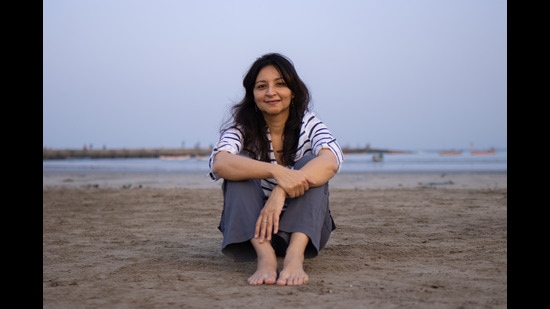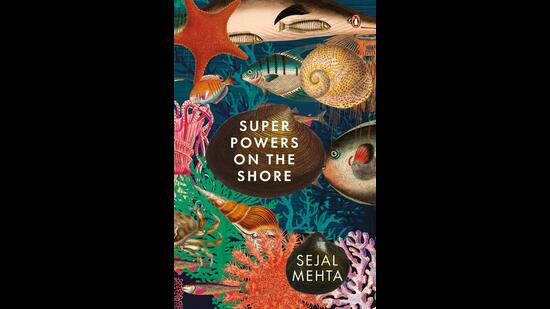Interview: Sejal Mehta, author, Superpowers on the Shore – “I wrote the book I’d have liked to read”
Gunjan Ahlawat has designed a spectacular cover for your book
Gunjan Ahlawat has designed a spectacular cover for your book. Tell us about the exchanges that happened between the two of you.

Gunjan Ahlawat is a magician. The cover took an interesting journey to get here. We wanted something colourful and beautiful that stayed true to the theme. The first cut largely reflected deep sea creatures, not coastal. Gunjan, Manasi Subramaniam (my editor) and I discussed this and talked about the creatures that are in the book. Most of them are not charismatic but they are vital to the story. Gunjan took relevant species names from me, and incorporated those into the cover. I am beyond delighted that the name of the book is sitting on a bivalve! And it looks, as you said, spectacular!

The book made me think about how science, not faith alone, can help humans appreciate interconnectedness. You make science sound like poetry and philosophy. How did you arrive at the worldview and language that inform your work as a science communicator?
One of the things that lent itself to the idea of interconnectedness in nature is quite literal. The idea of the impermanence that the shore life deals with is such a powerful visual. Every few hours, water rushes over, and leaves a clean slate. Everything starts again. Homes are built, washed over, built again, over and over. It is such a lesson about second, third and as many chances. Or the reliable tide, which will never stop coming in. The tide shapes coastlines over centuries, in whatever way it can – by flowing over rocks, or under them, or between crevices. It makes its way. And through this, it defines our coasts. This is the philosophy, the romance of the story. How the tide moves, and how the moon affects it, how animals adapt – these lend themselves to the science of it. For example, I loved the uncomfortable parallel of the human idea of invisibility and our shadow selves, sitting in the same chapter with camouflage and the changing self in intertidal creatures. When these threads meet, it’s such an exciting canvas for a writer. The world view came together in each chapter in this way.
I wonder if the locals and tourists who visit Juhu beach see what you see. Does it frustrate you, or do you see this as an opportunity for you to help them discover? Tell us about the work you do with Marine Life of Mumbai and independently.
It does not frustrate me at all. I have lived in Mumbai my whole life and never even considered that a forest lies at this watery doorstep. We learn as we go along so, as the scientists introduced me to the shore, I do the same with people not yet charmed by the shore’s secrets.
As a writer, when I met the team of Marine Life of Mumbai (MLOM) four years ago, the potential of outreach and science communication appealed to me. Before I moved back to Mumbai from Bangalore (I was editor at Nature inFocus then), my work revolved around speaking with scientists and naturalists who worked in the wilderness. I would break down that information to make it simple for all audiences. I still work with media houses to do more of the same, and hopefully, in future books too. Science communication became my strength, and I used it to help MLOM with its outreach and to build a strong community of tide poolers.
Read more: Excerpt from Superpowers on the Shore by Sejal Mehta
What made you think that a book of this kind might be a great vehicle to tell your stories?
Right from the first few times I walked on shores with scientists, I knew that the sheer number of stories hiding under rocks and sand was huge. Each animal, each habitat had an astounding way to live and adapt. I wasn’t thinking in terms of a book immediately, but as I started to write stories for different media, the idea came together – this was a superhero kingdom and needed a suitable vehicle to carry it through.
My editor Manasi and I discussed the structure and tone a couple of times. We were both keen that this be read by people not yet charmed by intertidal superheroes, and that made it easier to arrive at this voice. The illustrations then complemented this thought process. Jessica Luis has a unique style – where she manages to make the animal look realistic and endearingly relatable all at once. Basically, we fired from all cylinders available.
The book is packed with research from academic books and scholarly journals but the narrative voice is immediate and conversational. How did you achieve this?
How did I achieve it? With tears and meltdowns! I am only half joking. It was sometimes excruciating to organise the science data that I was collecting. The book reads easy but it was difficult to write. I pored over research papers that I would have never gone near with a barge pole otherwise. I do not read science for pleasure, and don’t even read non fiction regularly, despite having a large appetite for information. And I know there are more like me out there. So, in a way, I wrote the book I’d have liked to read. I have been lucky to have had access to marine biologists who looked at the first draft and checked facts. In terms of tone, friends who read small bits liked the ease of the information and laughed at and along with the creatures. That gave me the confidence that it was the right tone to take.
Review: Superpowers on the Shore by Sejal Mehta
How did the chapter Let’s Talk About Sex, Baby fall into place? Do you think that science teachers who are embarrassed about discussing sex and reproduction might find it helpful to pick that up and ease their way into talking about humans?
That chapter just came from the bizarre stories I had heard while walking the shores with scientists. One of the first things that I heard about was the species of hermaphrodite flatworms that stab each other with their penises in an attempt to impregnate the other. Or the sea hares who have sex standing in a line. Or the time that Abhishek Jamalabad (one of the founders of the Marine Life of Mumbai collective) and I saw medusae being released into the water from hydroids like little comets in a galaxy. The shore life has so many different ways to achieve their reproduction goals that I had to put aside an entire chapter for this.
It’s interesting that you would ask me about this being a bit of a story that teachers would use. I didn’t really think of it like that when writing it. In fact, I thought that chapter might shock kids because it was so bizarre. But used by teachers, it might be a good way to start talking about reproduction as a concept.
What are some of your fondest memories of seas and shores across the world?
I’ve been to some spectacular shores in my life but alas, I was too ignorant to look closer. Now, I can’t wait to the see the shores I haven’t yet been to, not just abroad but even here in Gujarat. The intertidal in some of these areas is several kilometres. What a treasure these spaces must be! To me, the beach has started to feel like a safe space, and some of my fondest memories are of a group just enjoying the space, the habitat. Tide pooling is yet another wildlife activity, like birding or a safari, and I’d like people taking it up for pleasure, and to see their coasts in a different way. I love the time when, after shore walks, people would gather and sit around on the rocks or the sand and talk about the city, and the ways they navigate their backyards, and the lives that inhabit these spaces. That’s why the book is not just about animals. It’s about us, as well, and what the shore and its powers can teach us about our own powers.
Chintan Girish Modi is a writer, journalist and educator who tweets @chintanwriting





